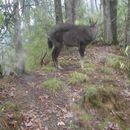mk
имиња во трошки


Himalayan gorals are also known as grey gorals.
Himalayan gorals rely on their vision and hearing to sense their surroundings. Their acute sense of sight allows them to see predators while they rest or graze. These animals use a series of snorts, whistles, and sneezes to indicate alarm to other gorals. Like most other mammals, it is likely that olfaction is an important sense as well.
Communication Channels: visual ; acoustic
Other Communication Modes: pheromones
Perception Channels: visual ; tactile ; acoustic ; chemical
Himalayan gorals are listed as near threatened as of 2008 by the IUCN. They are also on Appendix I of CITES. Populations are declining due to habitat loss and hunting. As humans begin to construct roads that spread deeper into the mountains of the Himalayas, populations of Himalayan gorals increasingly lose habitats that suit their isolated nature. Additionally, advances in weapon technology allow hunters to kill gorals from farther distances.
One study found that Himalayan gorals graze primarily on several grasses that are endemic to the Himalayas. If Himalayan gorals become more seriously endangered, human cultivation of these grasses could provide surviving Himalayan gorals with a reliable and preferred food source.
US Federal List: no special status
CITES: appendix i
State of Michigan List: no special status
IUCN Red List of Threatened Species: near threatened
There are no known adverse affects of Naemorhedus goral on humans.
Humans hunt Himalayan gorals for meat, wool, and hides. Goral blood is also used medicinally in some Asian cultures, although its efficacy is not proven.
Positive Impacts: food ; body parts are source of valuable material
Himalayan gorals are grazers, impacting vegetation communities in their mountain habitats. They also provide valuable source of nutrition for several predators that inhabit the unforgiving crags of the Himalayas.
Himalayan gorals are herbivores and eat a wide range of vegetation including herbs, shoots, roots, twigs, lichen, fungi, leaves, and grasses.
Plant Foods: leaves; roots and tubers; wood, bark, or stems; seeds, grains, and nuts; flowers; bryophytes; lichens
Other Foods: fungus
Primary Diet: herbivore (Folivore )
Himalayan gorals range throughout the Himalayas from Bhutan to Pakistan.
Biogeographic Regions: palearctic (Native ); oriental (Native )
Naemorhedus goral occupies the forests and scrub-covered slopes of the of the Himalayas. Himalayan gorals can be found at elevations from 1000 m to 4000 m.
Range elevation: 1000 to 4000 m.
Habitat Regions: temperate ; terrestrial
Terrestrial Biomes: chaparral ; forest ; scrub forest ; mountains
The expected lifespan of Himalayan gorals, once they have survived to maturity, is 15 years.
Average lifespan
Status: wild: 15 years.
Himalayan gorals are medium sized herbivores and are the smallest of the goat-antelopes (subfamily Caprinae). They range in body length from 81 to 130 cm and stand 56 to 80 cm tall. Himalayan gorals weigh from 25 to 30 kg. They are stout animals; a strong and stocky build is probably advantageous for maneuvering the craggy terrain of the Himalayas. Male and females are similar in size and both genders have short, sharp horns that curve posteriorly. Horns are rarely longer than 15 cm. Himalayan gorals are dark grey or brown with a darker colored dorsal stripe and a lighter patch of hair on the throat. The hair is short and coarse and males have manes from their necks to their chests. Himalayan gorals lack a pre-orbital gland, which is present in closely related serows.
Range mass: 25 to 30 kg.
Range length: 81 to 130 cm.
Other Physical Features: endothermic ; homoiothermic; bilateral symmetry
Sexual Dimorphism: sexes alike; ornamentation
Snow leopards, Eurasian lynx, wolves, wild dogs, and humans all prey on Himalayan gorals. The dark grey pelage of Himalayan gorals and their relatively sedentary behavior during the day allow them to blend in with the surrounding mountainside. Their agility in rough terrain also helps them to avoid less sure-footed predators.
Known Predators:
Anti-predator Adaptations: cryptic
Himalayan gorals are polygynous. Dominant males have mating rights to all females in their ranges during the breeding season. This dominance is established through threatening displays and combat with other males. When Himalayan gorals fight, they attempt to wound the flank of their opponent with their small, dagger-like horns instead of engaging in head-to-head butting. Males court females with low stretches, lip curling, spraying of urine, and tail raising.
Mating System: polygynous
Himalayan gorals mate in November and December so that young are born in spring and early summer when vegetation is abundant. Females give birth to one young per breeding season. Gestation lasts roughly 6 months, after which the female gives birth in isolation. After several days of hiding, the young begins to follow the mother. Juvenile gorals are weaned 4 to 5 months after birth. They are sexually mature at 2 to 3 years of age.
Breeding interval: Himalayan gorals breed once yearly.
Breeding season: Himalayan gorals breed in November and December.
Range number of offspring: 1 to 1.
Range gestation period: 5 to 7 months.
Range weaning age: 4 to 5 months.
Range age at sexual or reproductive maturity (female): 2 to 3 years.
Range age at sexual or reproductive maturity (male): 2 to 3 years.
Key Reproductive Features: iteroparous ; seasonal breeding ; gonochoric/gonochoristic/dioecious (sexes separate); sexual ; fertilization ; viviparous
Female Himalayan gorals raise their young with no help from the males, as males only associate with herds during the breeding season. Young Himalayan gorals follow their mother until weaned and remain with the group to which their mother belongs after reaching sexual maturity.
Parental Investment: precocial ; female parental care ; pre-fertilization (Provisioning, Protecting: Female); pre-hatching/birth (Provisioning: Female, Protecting: Female); pre-weaning/fledging (Provisioning: Female, Protecting: Female); pre-independence (Provisioning: Female, Protecting: Female); post-independence association with parents